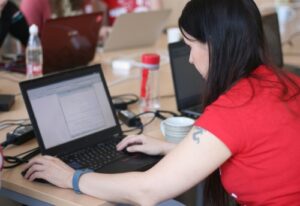Industry News and Information
5 Ways Technology can Help you Do Well in Your College Science Classes

Woman on a laptop computer, working with a group of female university students of computer science, programming code. Photo courtesy of Shutterstock.
STEM is an acronym for science, technology, engineering and mathematics. This acronym is used by the U.S. Department of Education when developing policies that will increase U.S. global competitiveness in the field of technology development. It’s been said that science and technology are advancing at such a rapid rate that, as a college student, much of what you’re learning right now may be obsolete by the time you graduate. However, here are some ways that technology is helping students succeed in science classes today, as well as preparing them for the advances of the future.
Information Sharing Technology
Some of the technology that has improved and enriched the information sharing process here are digital projectors and document cameras. Document cameras, unlike overhead projectors, have the capability of displaying three-dimensional objects, as well as making presentations interactive. Studies show that active participation increases information retention. Information sharing technology allows professors to more accurately and effectively gauge students’ level of understanding. It also increases the degree of flexibility teachers have to repeat information that addresses any gaps in understanding before proceeding to the next lesson.
Data Collection
One of the most useful new technologies for science classrooms is Probeware. There are now probes that use sensors that can measure motion, light, pressure, electric current, and temperature. The use of these sensors can reduce lab setup time and eliminate some time-consuming data collection steps. Another useful tool that is often used in conjunction with these sensors is the graphing calculator. They can be attached to a number of data collection devices such as electronic thermometers, light and decibel meters and others and interpret data collected by the devices in the form of graphs. Graphing calculators are especially useful in the scientific areas of statistics and mechanics.
Interactive Software
Most science courses require a strong foundation in mathematics. Educational institutions have found that integrating technology and math instruction with the use of interactive software increases the level of students’ engagement with the material. Software packages like ALEKS and MyMathLab have the advantage of allowing students to receive immediate feedback after completing problems, as well as guidance if their solutions are incorrect. For the sciences of anatomy and biology, there is three-dimensional software available that can even allow students to digitally replicate the process of dissecting a frog.
Data Examination
Because lab equipment, such as the microscopes used for analyzing and recording important data, is costly, some public schools have begun experimenting with digital microscopes. However, college science labs are well-equipped and many take advantage of technological advances that have resulted in a wider selection of microscope lights for analyzing data. Advances in the field of data examination include the development of fluorescence microscopy, which has proven important in the field of cellular biology research. Data is only useful when the methods and equipment used to collect and analyze it can ensure the degree of accuracy and precision required to maintain scientific and academic standards.
Instant Feedback
One of the advantages of all of these technologies is that they provide instant feedback. Another new invention popular with students and teachers that illustrates the value of instant feedback is the digital pen. Digital or “smart” pens allow students to take handwritten notes that are transferred to a digital page. That means no more clicking keyboards causing distractions in class. Many also have audio recording capabilities.
This is an exciting time for science and those educating themselves to make the next potentially world-changing contributions to the rapidly expanding encyclopedia of human scientific knowledge.
My name is Lizzie Weakley and I am a freelance writer from Columbus, Ohio. I went to college at The Ohio State University where I studied communications. I enjoy the outdoors and long walks in the park with my 3-year-old husky Snowball.